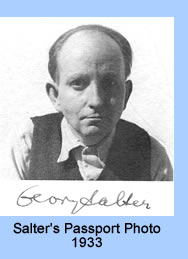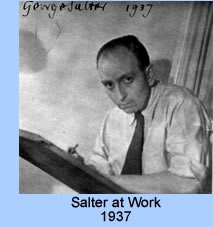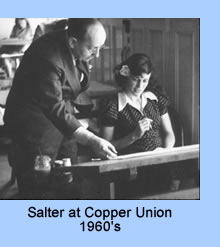
|
|

|
 |
Family Background
George
Salter was born in Bremen in North Germany on October 5, 1897. His
father, Norbert, studied at the Vienna Conservatory
and later played the cello in the Hamburg symphony orchestra under
the young Gustav
Mahler. His mother,  Stefanie, also came from a musically talented
Hungarian family. Norbert Salter eventually became the business manager
of the
Hamburg orchestra and expanded his interests to become a successful international theatrical agent.
Stefanie, also came from a musically talented
Hungarian family. Norbert Salter eventually became the business manager
of the
Hamburg orchestra and expanded his interests to become a successful international theatrical agent.
The Salters
had four children: Lili (who for a time studied photography with Lotte
Jacobi in Berlin); Georg (born in 1897, the oldest son); Julius; and
Stefan (born in 1907). In 1897 Salter's parents converted to Christianity,
following the path of assimilation typically taken by secular Jews in
Germany. George received his certificate of confirmation at the Kaiser-Wilhelm
Gedächtnis-Kirche in Berlin on March 13, 1913. The family enjoyed
a comfortable life of affluence in the era before the First World War.
The Salter apartment in the pleasant Grunewald suburb of Berlin often
welcomed Norbert Salter's famous friends and clients from the cosmopolitan
music and theater world. In this ambiance George grew up playing the
cello and experimenting with technical problems of set design, costumes,
and lighting.
Designing for Berlin Publishers
Salter’s diploma from secondary school,
the Werner Siemens Realgymnasium zu Schöneberg (Berlin)
in 1911, records his grades. Among these is, ironically, a “satisfactory” in
penmanship – possibly because of his left-handedness at a
time when schools enforced right-handedness. Salter eventually
taught
himself to write and draw with his right hand, which he later urged
his own
students to do. In 1916 at age nineteen, Salter finished secondary
school (Gymnasium) and immediately joined the German army. One
of his duties
was mapmaking, which further advanced his nascent skill as a draftsman.
He and his brother Julius survived the war unharmed and returned
to civilian life to devote themselves to different aspects of
the book trade. While Julius helped to found the family publishing
firm
of Verlag
Die Schmiede, George, upon his return to civilian life, began to
study art. He enrolled in the Kunstgewerbe- und Handwerkerschule [School
of Applied Arts and Crafts] in Berlin-Charlottenburg, where from
1919-1921 he concentrated on scene painting. From 1921-1922 he
worked at the studio
for stage design at the Prussian State Opera.
Beginning in 1922 Salter devoted himself professionally to theatrical
design while free-lancing as a book designer. There is no denying that
dramatic qualities
of light, as well as stylized angles of vision and perspective, are apparent
in his work throughout his career. Salter also worked for the Berliner
Volksoper where he designed several productions. When the Volksoper was
disbanded in 1925, Salter
took a job in the provinces, where he became engulfed by the work load
at Die
Vereinigten Stadttheater Barmen-Eberfeld [United Municipal Theaters
of Barmen-Eberfeld]. For this theater Salter designed productions for
over 100
plays, operas, and
operettas. In 1927 the taxing workload finally became unbearable, and
Salter returned to Berlin to concentrate on book design where his reputation
rose
steadily as his virtuosity increased. As his early jobs show, his mastery
of the craft developed rapidly and assuredly during his first years in
the business,
the time when he was still working in the theater.

During this important period between 1922 and 1934 Salter produced over 350
different designs for 33 different German publishers. While many are binding
designs, over two thirds of these were book jackets. Between 1927 and 1933
he designed several jackets that became his trademark and greatest legacy.
He had the good fortune to see his designs paired with bestsellers by major
writers, which brought him name recognition in the circles of both literature
and commercial design.
Salter came to the attention of the talented calligrapher and typographer,
Georg Trump, who hired him to direct the Commercial Art Department at
the Höhere Graphische Fachschule [Institute of Graphic Arts]
in Berlin in 1931. Trump and Salter came to share a profound respect as
colleagues
and friends, but Trump was nonetheless forced to dismiss Salter from the
state-run institution early in 1933 in accordance with the racial laws
of the new regime. After losing his teaching position, Salter left the
capital that had celebrated and rewarded his talents. He first moved to
Baden-Baden in May, 1933, where he awaited his American visa, which finally
came through the consulate in Stuttgart on October 1, 1934. His brother
Stefan (who had gone to the United States in 1928) submitted an affidavit,
which helped Georg join the first wave of refugee artists and intellectuals
to leave Germany.
Emigration: New Beginnings in New York
The émigré who arrived in New York on Friday, November 16, 1934, was already earning money by the following Monday. Good fortune of this order usually depends upon guardian angels working behind the scenes. In Salter’s case, friends and patrons all played significant roles in easing his transition. Hellmut Lehmann-Haupt for example, (who had come to the United States in 1929) was Curator of the Department of Rare Books at Columbia University from 1930 to 1937 and an historian of the American publishing trade devoted to the art of the book. He mounted an exhibition of 50 book jackets by Salter at Columbia University in November, 1933. Salter thus arrived in New York with contacts in the publishing business and a reputation already established.
Salter’s first workplace
was a desk at the H. Wolff Book Manufacturing Company on West 26th
Street, an important bindery for the American book trade, where he
established himself as a freelance designer and jacket artist. Salter’s
informal but fruitful association with H. Wolff provided a superb
introduction to the design departments of all the major New York
publishers. He had found the ideal place to hang his hat as he improved
his English, adjusted to his new homeland (where to the amusement of
colleagues, he rejoiced in paying taxes), and established his reputation
before striking out on his own. His reputation paved the way for a
teaching contract at Cooper Union in 1937 where he began to offer courses
in calligraphy and lettering. The students in those classes (where
he taught for 30 years), and at New York University (where he briefly
offered an evening course on book design) include many illustrious
names in the generation of designers that followed.

From Georg to George
The
decade of the 1940s brought Salter continued professional
advancement so that by the end of 1940 he had
produced approximately 185 book jackets and at least 30 magazine
covers since arriving in the United States – more than
one per week. The most significant personal event of the year
was his
naturalization
as
American citizen on September 19, 1940. Forever after this
day he signed his name George Salter. In that year he registered
his
income as $5,000 – a
clear reflection of the market opportunities that had opened
to him. In the same year he was also able to help the rest
of his family escape
from Paris. Work was steady and life tranquil for Salter
and his reputation with New York publishers increased steadily.
Publishers
coveted his
designs and book jackets for their annual lists and professional
colleagues held him in the highest esteem. Salter’s election
to membership in the Grolier Club (New York City) in 1951 attests
both to his
character and professional status among bibliophiles and
book professionals.
In the United States his first covers in the detective-mystery
genre eventually led him into an association with
the publisher Lawrence Spivak, who had a small
empire of inexpensive detective and science fiction serials. Salter
came to Mercury Publications in 1938 to help manage the success
of the venture and
was made art director in 1939. He designed the various series to
give each a distinctive look within the so-called digest
format. For
all his mystery
magazine designs, Salter stayed closer to the style of highbrow
publishing graphics than to pulp fiction. A certain taste
and deliberate restraint
sets Salter’s mystery covers apart from the lurid
excesses of many contemporaneous paperback jackets
that today find
an ironic appreciation for their camp effects.
George Salter died on October 31, 1967, in New York
City. He is buried beside his wife Agnes O’Shea
Salter (1901-1989)
in Cummington, Massachusetts, in the Hampshire
Hills where the family used to spend their summer vacations.
In retrospect Salter’s designs reveal a graphic artist par excellence who devised some of the best solutions ever posed by the genre of the book jacket. Salter had the fortunate ability to reduce the illustrated paper cover to its essential elements. He could visually evoke – either by typography, calligraphy, or pictorial imagery – the atmosphere of a volume’s contents. In short, by placing the highest design standard at the service of the publishing trade, he achieved the marriage of commerce and art.
- Created By: Sara Kratzok '06 & Devyani Parameshwar '06
- Maintained By: Author, Thomas S. Hansen, Dept. of German, Wellesley College
- Date Created: July 2, 2004
- Last Modified: October 28, 2004
- Expires: August 2005



